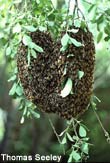Bees Form Better Democracy

Take it from bees. Intense competition is better than touchy-feely "win-win" negotiations when it comes to making big decisions.
Ten years of painstaking research on how swarms of honeybees choose a new hive now shows their voting process for selecting new real estate is efficient and yields some losers while avoiding the folly of the collective, or of trying to come to a consensus.
The bees' approach might sound hardcore and less than democratic. But it almost always results in the choice of the best home among available options, said Thomas Seeley of Cornell University.
A better democracy
If humans were to take a page from honeybee home hunting, we too could learn to minimize bad decisions, he said.
"How the scout bees select candidate sites, deliberate among choices and reach a verdict is a process complicated enough to rival the dealings of any corporate committee," Seeley wrote in a recent article in American Scientist magazine summarizing his research.
Seeley and his colleague, Kirk Visscher of the University of California-Riverside, tagged, observed, videotaped and experimented with swarms of up to 10,000 honeybees at Appledore Island in the Gulf of Maine. The setting has few trees, which allows Seeley and Visscher to set up test homes (boxes) from which the bees can choose.
Get the world’s most fascinating discoveries delivered straight to your inbox.
Here is what they found: When bees outgrow their hives, a few hundred scouts selected by the queen search for the perfect, new location for a swarm—a south-facing knothole that is smaller than 4.7 square inches, perched several yards above the ground and leads to a hollow in the tree that is at least 5 gallons in volume.
Scouts return to the waiting swarm and perform a waggle dance, vibrating their abdomens laterally while walking in figure eights, to report on what they found. The longer the waggle dance, the better the site. This prompts other scouts to visit the recommended site.
Competition
Scouts compete to attract uncommitted scouts to visit their sites. As time passes, coalitions form that prefer one site over another.
Instead of hashing it out endlessly, the group usually makes a decision with no more than 16 hours of dancing debate. As soon as 15 or more bees are at any one site, the scouts signal to the waiting bees in the swarm to warm up their flight muscles. Soon, the swarm lifts off toward its new home.
"The bees' method, which is a product of disagreement and contest rather than consensus or compromise, consistently yields excellent collective decisions," Seeley said.
An open forum for opinions and a decentralized, competitive "debate" that filters out extreme or inaccurate opinions are the key features that make the bees' decision-making process effective, Seeley said.
Americans value democracy, or at least a representative version of it. Honeybees have evolved to rely on this quorum or majority method to collect independent opinions, something that differs from a one-man, one-vote democracy or an agonizing attempt to hammer out something everyone agrees upon.
It's a faster route to a swift and also smart decision, Seeley said.
Robin Lloyd was a senior editor at Space.com and Live Science from 2007 to 2009. She holds a B.A. degree in sociology from Smith College and a Ph.D. and M.A. degree in sociology from the University of California at Santa Barbara. She is currently a freelance science writer based in New York City and a contributing editor at Scientific American, as well as an adjunct professor at New York University's Science, Health and Environmental Reporting Program.

